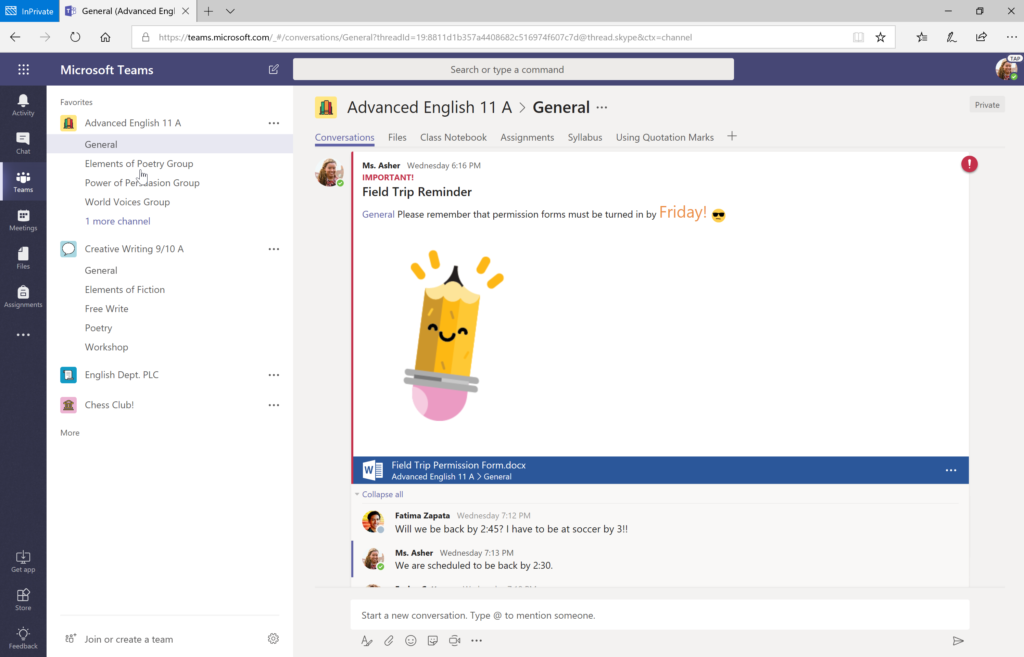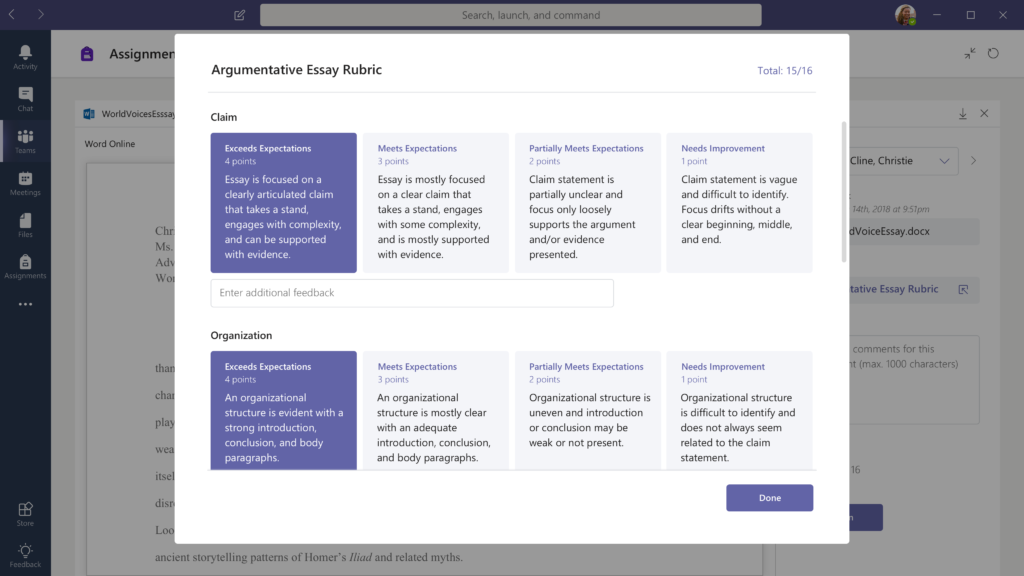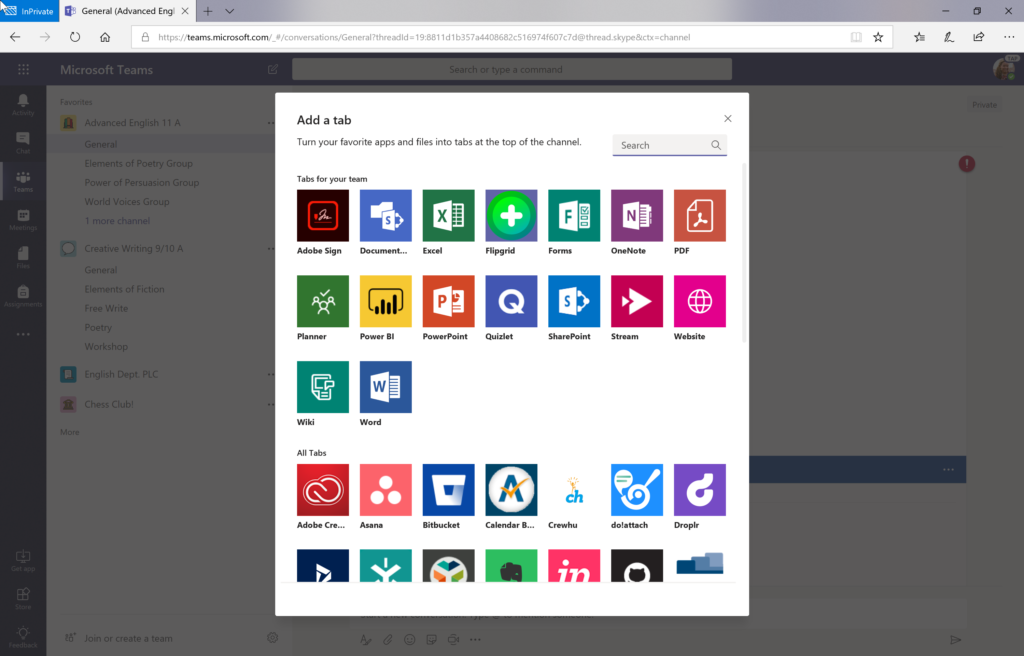
This is a sponsored post. All opinions are my own.
We’ve reached the point where we have a lot of fantastic tools for enhancing our instruction, but everything is scattered: One piece of information comes through email, another conversation happens in a text, and another file is sent to us through Facebook messenger. We keep multiple tabs open for dozens of websites, toggle between apps, check notifications in four different places.
And we’re used to it, more or less. It’s fine. But wouldn’t it be nice if we could put all of our school-related communication in one place?
Microsoft Teams gives us that one place and so much more. It’s a seamless platform that not only streamlines your teaching workflow, but also makes it possible for you to create a space for more robust collaboration between your students.
Let’s look at how Teams works and what it can do for you.
What is Microsoft Teams?
Think of Microsoft Teams as a hub where you and your students interact online, a workspace where you can communicate, share files, and even meet online. This video shows how it works:
Key Features
Communication and Collaboration
Using the Microsoft Teams platform, teachers and students can communicate one-on-one or in groups:
- Teachers can send messages and announcements to individual students or whole classes at once. Individual users can create private chats with other users.
- With the Channels feature, teachers can create sub-categories within each team for file storage, special projects, or focused topics.
- Users can conduct video meetings using built-in Skype technology or participate in video discussions with Flipgrid, which is also integrated right into the platform.
- Teachers can use OneNote Class Notebooks to share notes and files and give feedback to individual students. Notebooks can also be shared between faculty members to collect and curate resources, collaborate and develop new documents, and share professional development materials.

Teams are listed in the column on the left. Within each team, separate
channels can be created to keep discussions and materials organized.
Assignments
Microsoft has recently added assignment management tools; many of these features came from the Chalkup platform, which joined Microsoft earlier this year. With this new addition, teachers can now manage their assignments without ever leaving the Teams environment.
With the Assignments tools, teachers can:
- Create, assign, collect, and give feedback on assignments.
- Attach relevant files—Microsoft Office tools like Word, PowerPoint, Excel, and OneNote are built right into the platform, so you can create with these tools and assign students to do the same.
- Create, save, and use rubrics to assess student work: The rubric builder is customizable and allows users to add written feedback and go back and adjust a score later. (Microsoft is also working on adding single-point rubric capabilities to the tool!)

With the rubric feature in Teams, you can create robust rubrics, use them to
assess student work, and save them to reuse or adapt for other assignments.
App Integrations
I love this feature: When you need to take things up a notch, you can use some of the most popular apps in education right inside the Teams environment, including Kahoot!, Nearpod, Quizlet, and Flipgrid. If a particular app will be used frequently by a group, you can add a designated tab to a channel just for that app, so users can get to it quickly.

Many of your favorite educational apps are integrated with Teams. You can
use them without ever leaving the Teams platform.
Nothing to Download, Nothing to Buy
Microsoft Teams is all cloud-based, meaning you don’t have to buy new software or install anything. And it’s all completely free for educators and students who have an Office 365 Education subscription (which is also available for free).
On top of that, you can use Teams on the go: Just put the iOS or Android app on your mobile device and you can access your classroom from anywhere.
How Teams Could Change the Way You Work
There’s something to be said for integration: With so much of what you need built into one seamless platform, you no longer have to deal with the hassle of mixing your accounts, multiple sign-ins and toggling back and forth between apps. And having that hassle simply disappear frees up time and energy to settle in and really take advantage of what these tools have to offer.
- Having the ability to set up a quick video call with a teacher down the hall means you’re much more likely to collaborate, and that means better teaching.
- Knowing students can collaborate in a seamless environment means you can assign more collaborative projects, and you’ll be able to monitor how things are going in each group.
- Getting everyone trained on a platform where each person can participate levels the playing field for introverts—even quiet students have the opportunity to have an active voice in discussions.
- Having a central location for professional learning and collaboration—where you and your colleagues can share information and discuss important issues and projects—could mean fewer time-consuming meetings.
Where Do You Even Start?
The capabilities of Microsoft Teams can seem overwhelming at first. And if you’re already running a lot of your other systems on other platforms, the thought of starting something new may be daunting.
Here’s what I suggest: Pick one project and try operating the whole thing through Microsoft Teams. This could be an event or fundraiser, a short-term committee, or a teacher book study. Make it something that’s got a definite end point, and have everyone involved commit to sticking with it.
There will be some growing pains as everyone gets used to navigating it, but think of it as a learning experience. Once you’ve tried Teams out with a single project, you’ll have a better idea of how you might want to use it in other areas.
More to Come
Over this past year I have become more familiar with the innovations Microsoft is adding to their repertoire, and I’m more impressed with every new layer I uncover. From their accessibility tools to their STEM resources to the incredible power of Teams, Microsoft is putting an incredible amount of time, energy, and brain power into innovating for schools. I can’t wait to see what they do next. 
For a more in-depth look at Microsoft Teams, check out this 8-part video series.
Join my mailing list and get weekly tips, tools, and inspiration that will make your teaching more effective and fun. You’ll get access to our members-only library of free downloads, including 20 Ways to Cut Your Grading Time in Half, the e-booklet that has helped thousands of teachers save time on grading. Over 50,000 teachers have already joined—come on in.
















